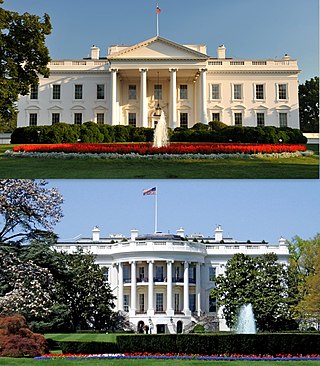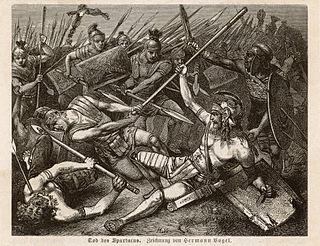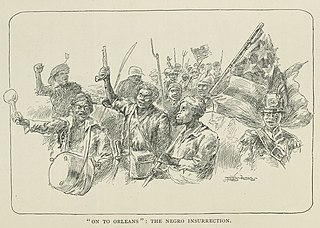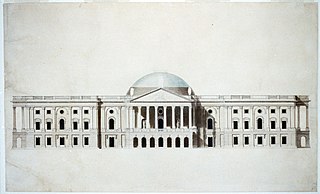This article needs additional citations for verification .(January 2021) |
Multiple rebellions and closely related events have occurred in the United States, beginning from the colonial era up to present day. Events that are not commonly named strictly a rebellion (or using synonymous terms such as "revolt" or "uprising"), but have been noted by some as equivalent or very similar to a rebellion (such as an insurrection), or at least as having a few important elements of rebellion (such as an armed occupation of government property), are also included in this list. Anti-government acts by individuals are not included.
| Name: | Date: | Location: | Events: | Rebel Groups: | Result: | Notes |
|---|---|---|---|---|---|---|
| Bacon's Rebellion | 1676 | Colony of Virginia | Bacon's forces attacked many of the neighboring Native tribes before driving governor William Berkeley from the capitol of Jamestown, burning the city. [1] | Virginian settlers led by Nathaniel Bacon | Suppressed by the Virginian colonial authorities after receiving reinforcements from privateer Thomas Larimore. The rebel forces, being composed of a mix of classes and races – many slaves and indentured whites among them – inspired the passing of the Virginia Slave Codes of 1705. [2] | |
| Boston Revolt | April 18, 1689 | Dominion of New England | Popular uprising against the rule of Edmund Andros, the governor of the Dominion of New England. Dominion officials were arrested. Members of the Church of England were also taken into custody if they were believed to sympathize with the administration of the dominion. [3] | Boston colonists | Militia took control of Boston, reestablishing the Colony of Massachusetts Bay and Ending the Dominion of New England. Massachusetts's charter was permanently revoked in 1691. | |
| Leisler's Rebellion | 1689–1691 | Province of New York | German American merchant and militia captain Jacob Leisler seized control of the southern portion of colonial New York and ruled it from 1689 to 1691. [4] | Leislerians | Nine Years War militia members rebelled, took control of New York City and made merchant Jacob Leisler governor. The crown retook control two years later and executed Leisler. [5] | |
| War of the Regulation | 1765 – May 16, 1771 | Colony of North Carolina | War of the Regulation Battle at the Yadkin River Battle of Alamance | Regulators | Result – Decisive government victory. [6] Royal governor of North Carolina, William Tryon and General Hugh Waddell (general) with 1,500 men; 2,300+ Regulators Led by Commanders and leaders Herman Husband, James Hunter, James Few (POW), Charles Harrington; Benjamin Merrill (POW) – Executed | |
| American Revolution | 1765–1783 | North America | American Revolutionary War Boston campaign Boston Massacre Pine Tree Riot | The Thirteen American Colonies rejected British colonial rule, overthrew the authority of the British Crown, and founded the United States of America. | ||
| Shays' Rebellion | August 1786 – June 1787 | Western Massachusetts | Paper Money Riot | Anti-austerity protesters and discontented Revolutionary War veterans led by Daniel Shays | Rising up against economic injustices and suspension of civil rights by Massachusetts. [7] Won economic reforms in a landslide election shortly after protestors were dispersed by a privately raised militia at the Springfield Armory. [8] Contributed to the convocation of the Constitutional Convention after the government established by the Articles of Confederation could not raise troops. | |
| Whiskey Rebellion | 1791–1794 | Western Pennsylvania | Frontier tax protesters | Tax protest in the United States beginning in 1791, over 175 distillers from Kentucky were convicted of violating the tax law. [9] Suppressed by an army personally led by President Washington | No specific events | |
| Fries's Rebellion | 1799–1800 | Rebel farmers | Armed tax revolt among Pennsylvania Dutch farmers. Thirty men went on trial in Federal court. [10] | |||
| State of Muskogee | 1799–1803 | Florida | William Augustus Bowles, various tribes of Southeastern Native Americans | Bowles attempted to unite all the Native Americans to form a single country. [11] | Andrew Jackson destroyed the capitol Miccosukee—the largest town in Florida at the time—in 1817. | |
| 1811 German Coast Uprising | January 8–10, 1811 | Territory of Orleans | Rebel slaves | Between 64 and 125 enslaved men marched from sugar plantations near present-day LaPlace on the German Coast toward the city of New Orleans. [12] Militia companies were used to hunt down and kill the insurgents. | ||
| Nat Turner's slave rebellion | August 21 – 23, 1831 | Southampton County, Virginia | Rebel slaves | Led by Nat Turner, rebel slaves killed anywhere from 55 to 65 people. [13] The rebellion was put down within a few days. [14] Local blacks were massacred. Led to discriminatory legislation against both free blacks and slaves | ||
| Dorr Rebellion | 1841–42 | Rhode Island | Attempt to force a new government of Rhode Island under a new constitution that allowed more men to vote [15] | Dorrites | Charterite victory, but later legal expansion of voting rights | |
| 1842 Slave Revolt in the Cherokee Nation | 1842 | Indian Territory | Rebel slaves | Slaves escape and fight police, eventually captured. [16] | ||
| Anti-Rent War | 1839–1845 | Upstate New York | Anti-Renters | The tenants could not pay the amounts demanded, could not secure favorable terms, and could not obtain relief in the courts, so they revolted against the patroon system. [17] There were trials of leaders of the revolt. | ||
| Taos Revolt | January 19 – July 9, 1847 | New Mexico | Cienega Affair Las Vegas Affair Red River Canyon Affair Second Battle of Mora | Local rebels | New Mexicans and Pueblo allies rebel against the United States' occupation of present-day northern New Mexico during the Mexican-American War. [18] The rebels fought but after being defeated they abandoned open warfare. | |
| John Brown's raid on Harpers Ferry | October 16–18, 1859 | Harpers Ferry, Virginia | Abolitionists John Brown, Shields Green, John Henry Kagi and 21 known followers | Abolitionist John Brown initiates an armed slave revolt. [19] Eleven rebels killed and eight captured by U.S. Marines led by Col. Robert E. Lee, Lt. J.E.B. Stuart, and Lt. Israel Greene. | ||
| American Civil War | April 12, 1861 – May 9, 1865 | Southern United States | Eastern Theater of the American Civil War Western Theater of the American Civil War Lower Seaboard Theater of the American Civil War Trans-Mississippi Theater of the American Civil War Pacific Coast Theater of the American Civil War | Seven Southern slave states seceded from the United States of America in response to the election of Abraham Lincoln as president. [20] Four more Southern states seceded in response to Lincoln's call for 75,000 volunteers to put down the rebellion. [21] These states formed the Confederate States of America. After four years of bloody warfare and over one million total casualties, the Confederates were defeated and Union reestablished. [22] See Reconstruction for aftermath. | ||
| New York City draft riots | July 13–16, 1863 | Lower Manhattan, New York City, New York | Riots expressing discontent with new draft law; white attack on blacks because of economic competition. [23] | Residents of New York City | New York Guard and Union Army troops restored order. | Largest civil and racially-charged insurrection in American history. [24] |
| Battle of Liberty Place | September 14, 1874 | New Orleans, Louisiana | White League | Attempted insurrection by the Crescent City White League against the Reconstruction Louisiana state government. [25] Federal troops restored the elected government. | Part of anti-Reconstruction violence against the Union. | |
| Election Riot of 1874 | November 3, 1874 | Eufaula, Alabama | White League | White supremacists take Republicans out of office and declared the Democrats as winners [26] | Part of anti-Reconstruction violence against the Union. | |
| Greenwood, New York, insurrection of 1882 | February 1882 | New York Governor Alonzo Cornell proclaimed a state of insurrection after local residents resisted the seizure of property to pay for railroad bonds from the Rochester, Hornellsville, and Pine Creek Railroad. [27] Residents of Greenwood refused with violence and threats of more violence in response to the governor's attempts to get the citizens to pay a tax levied to repay money that Greenwood had borrowed to help construction of a never-built railroad. | Citizens of Greenwood | Taxes paid, insurrection ended at threat of calling out militia. | Molly Maguires said to be involved. | |
| Wilmington insurrection of 1898 | November 10, 1898 | Wilmington, North Carolina | Waddell's Army Segregationist rioters | Successful removal of local government, retaining segregationist policies. [28] | ||
| Green Corn Rebellion | August 2–3, 1917 | Seminole County, Oklahoma | Rebel farmers | The uprising was a reaction by radicalized European-Americans, tenant farmers, Seminoles, Muscogee Creeks and African-Americans to an attempt to enforce the Selective Draft Act of 1917 during World War I. [29] The country rebels met with a well-armed posse of townsmen, with whom shots were exchanged and three people killed. | ||
| Coal Wars | c.1890 – 1930 | Eastern United States and Colorado | Coal Creek War Colorado Coalfield War Battle of Blair Mountain | Miners and unions | The Coal Wars, or the Coal Mine Wars, were a series of armed labor conflicts in the United States, they occurred mainly in the East, particularly in Appalachia. [30] | |
| Battle of Athens (1946) | August 1–2, 1946 | McMinn County, Tennessee | Angered citizens, including World War II veterans | Citizens assaulted buildings in response to voter intimidation and election corruption. [31] This later resulted in reforms. | ||
| San Juan Nationalist revolt | October 30, 1950 | Puerto Rico | Jayuya Uprising Utuado Uprising | Nationalist revolt that took place on October 30, 1950, in the town of Jayuya, Puerto Rico. [32] The top leaders of the Nationalist party were arrested, including Albizu Campos and Blanca Canales, and sent to jail to serve long prison terms. | ||
| Black Power movement | 1960s – 1980s | Nationwide | Glenville shootout 1969 Greensboro uprising | Black Guerilla Family Black Liberation Army Black Panther Party Black Revolutionary Assault Team George Jackson Brigade M19CO MOVE Symbionese Liberation Army Weather Underground White Panther Party | Radicalization of the Civil Rights Movement. | |
| Red Power movement | 1960s – 1970s | Wounded Knee incident | American Indian Movement | Radicalization of a Native American movement. | ||
| Occupation of Alcatraz | November 20, 1969 – June 11, 1971 | Alcatraz Island, San Francisco Bay, California | Native American activists, calling themselves as "Indians of All Tribes" seized the island of Alcatraz and lived there for two years. Though, probably related to the broader Red Power Movement, the main group of the movement, the American Indian Movement claimed that they were never involved in the occupation. | Indians of All Tribes | Occupation ended after several federal agencies swarmed the island and removed the remaining occupiers. | |
| Attica Prison riot | September 9–13, 1971 | Attica Correctional Facility, Attica, New York | Prison riot after the killing of George Jackson | Inmates | Prison is retaken by the New York State Police on orders from Governor Nelson A. Rockefeller. [33] | No specific events |
| Occupation of Catalina Island | August 30 – September 22, 1972 | Santa Catalina Island, Los Angeles County, California | Seizure of Santa Catalina Island by pro-Chicano militia. | Brown Berets | Los Angeles County Sheriff recaptured the island, the Brown Berets surrendered without resistance. | |
| 2014 Bundy Standoff | April 5–14, 2014 | Bunkerville, Nevada | Armed confrontation between Cliven Bundy's militia allies and the Bureau of Land Management over Bundy's refusal to pay fees for grazing his cattle on federal land, as Bundy asserted the federal government had no right to own the land. [34] Bundy also alleged that the BLM attempted to "round up his cattle". [35] | Oath Keepers Three Percenters Other local militia groups tied to the American militia movement | Bureau of Land Management ends attempt to round up cattle but continues actions in court. Bundy's son and friends would later occupy a wildlife refuge in Oregon for similar goals. | Related to the Occupation of the Malheur National Wildlife Refuge |
| Occupation of the Malheur National Wildlife Refuge | January 2, 2016 – February 11, 2016 | Malheur National Wildlife Refuge, Harney County, Oregon | Seizure and occupation of federal property by an armed group. [36] The participants were acting on their view that the federal government is constitutionally required to turn over most of the federal public land they manage through federal agencies, to the individual states. [37] | Radical right militias led by Ammon Bundy | Occupation ended by police followed by criminal proceedings and convictions. Most participants, including Ammon and Cliven Bundy, would be acquitted in federal court. | Related to the Bundy standoff. |
| Capitol Hill Occupied Protest | June 8, 2020 – July 1, 2020 | Seattle, Washington | Protesters take over The Seattle Police Department's East Precinct and the surrounding region, declaring an autonomous zone. The city government was both unwilling and unable to control agitation, with the Seattle mayor describing the atmosphere to be "more like a block party atmosphere" than an "armed takeover." [38] contrasting with other reports that said that there were "roving bands of masked protesters smashing windows and looting" [39] and the Seattle Police Chief saying that there are "Rapes, robberies and all sorts of violent acts have been occurring in the area" [40] | George Floyd protesters | The zone was cleared of occupants by police on July 1. | Part of the Defund the Police movement |
| 2021 United States Capitol attack | January 6, 2021 | United States Capitol, Washington, DC | Supporters of President Donald Trump, some of whom were armed, stormed the Capitol building after a rally held in Washington D.C by the President, his sons, [41] and his personal attorney, Rudy Giuliani. [42] They broke through barriers, assaulting Capitol Police officers, and broke down doors, smashed through windows, and stole public property. [41] The supporters obtained access to the Senate Floor, balconies, and offices; and sat at the Senate President's desk. [41] | Supporters of President Donald Trump Far-Right groups: Oath Keepers, Proud Boys, Three Percenters, Groyper Army, America First Movement and others | Failure to overturn the presidential election; delay of counting electoral votes by several hours; [43] resumption of presidential transition leading up to the inauguration of Joe Biden. Second impeachment of Trump. [44] Other political, legal, and social repercussions. | Part of the attempts to overturn the 2020 United States presidential election Most severe assault on the Capitol since the 1814 burning of Washington by the British Army. [45] |















